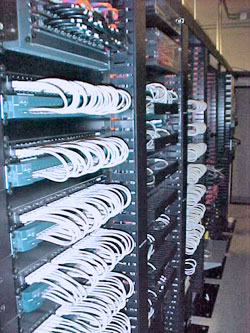Connectivity

The data center
LAN faces a number of challenges as enterprises are centralizing applications and consolidating servers to simplify
operations and reduce costs while business productivity increasingly depends on operations carried out at distributed
branch offices. As businesses continue to expand across the globe, downtime is not an option—a data center LAN must efficiently operate 24x7.
These trends raise the density, scalability, throughput and high availability (HA) requirements of the data center LAN. Trying to support these needs with low-density, single-function legacy equipment is not only inefficient, it’s not cost effective, adversely affecting performance, reliability, valuable rack and cabinet space as well as driving power and
cooling costs higher. Enterprises are also moving towards applications that use a Service-Oriented Architecture (SOA ) and also provide Software as a Service (SaaS), both of which present a new set of throughput, performance and HA requirements for the data center LAN. New technologies such as virtualization are needed to increase scalability,
efficiency and lower total cost of ownership.
These changes, coupled with IT initiatives such as Unified Communications, require that data center LANs operate with the same carrier-class reliability and performance demanded by fee-based service providers. Existing data center infrastructure solutions cannot meet these requirements, nor do they provide the unified management capabilities
critical for reducing costs and streamlining operations.
Simply designing a data center that only deploys more servers, more storage, and more devices significantly increases
network complexity and cost. Legacy solutions are inefficient; for example, more than 50 percent of Ethernet switch
ports within the data center are typically used for switch interconnectivity. A new data center LAN design that meets the
growing performance demands of users and network-centric applications from a variety of locations is needed. It also
must economically scale and flexibly accommodate new computing trends and IT initiatives without an entire redesign.
WhitePaper
-
How Ethernet Works?
- Networking allows one computer to send information to and receive information from another
Data Center LAN Connectivity Design Guide
How VPN Works?
VPN is a private network that uses a public network to connect remote sites or users together...
How Firewall Works?
A firewall is somply a program or hardware device that filters the information coming through the internet connection into your private network or computer system.
How LAN Switches Works?
Switches are a fundamental part of most networks. They make it possible for several users to send information over a network at the same time without slowing each other down....
How Routers Work?
Routers are specialized computers that send your messages and those of every other internet user speeding to their destinations along thousands of pathways...
How VDSL Works?
find out how does router works..